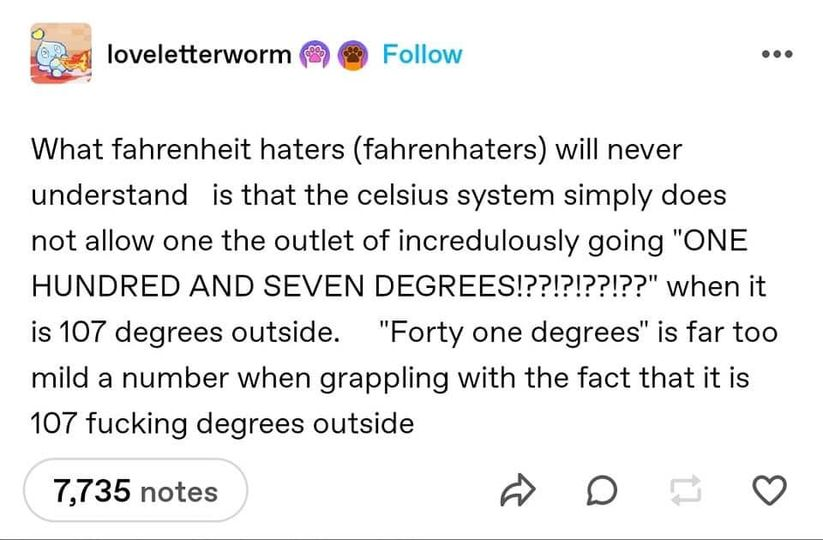this post was submitted on 09 Sep 2024
1186 points (92.2% liked)
Science Memes
11437 readers
1173 users here now
Welcome to c/science_memes @ Mander.xyz!
A place for majestic STEMLORD peacocking, as well as memes about the realities of working in a lab.

Rules
- Don't throw mud. Behave like an intellectual and remember the human.
- Keep it rooted (on topic).
- No spam.
- Infographics welcome, get schooled.
This is a science community. We use the Dawkins definition of meme.
Research Committee
Other Mander Communities
Science and Research
Biology and Life Sciences
- !abiogenesis@mander.xyz
- !animal-behavior@mander.xyz
- !anthropology@mander.xyz
- !arachnology@mander.xyz
- !balconygardening@slrpnk.net
- !biodiversity@mander.xyz
- !biology@mander.xyz
- !biophysics@mander.xyz
- !botany@mander.xyz
- !ecology@mander.xyz
- !entomology@mander.xyz
- !fermentation@mander.xyz
- !herpetology@mander.xyz
- !houseplants@mander.xyz
- !medicine@mander.xyz
- !microscopy@mander.xyz
- !mycology@mander.xyz
- !nudibranchs@mander.xyz
- !nutrition@mander.xyz
- !palaeoecology@mander.xyz
- !palaeontology@mander.xyz
- !photosynthesis@mander.xyz
- !plantid@mander.xyz
- !plants@mander.xyz
- !reptiles and amphibians@mander.xyz
Physical Sciences
- !astronomy@mander.xyz
- !chemistry@mander.xyz
- !earthscience@mander.xyz
- !geography@mander.xyz
- !geospatial@mander.xyz
- !nuclear@mander.xyz
- !physics@mander.xyz
- !quantum-computing@mander.xyz
- !spectroscopy@mander.xyz
Humanities and Social Sciences
Practical and Applied Sciences
- !exercise-and sports-science@mander.xyz
- !gardening@mander.xyz
- !self sufficiency@mander.xyz
- !soilscience@slrpnk.net
- !terrariums@mander.xyz
- !timelapse@mander.xyz
Memes
Miscellaneous
founded 2 years ago
MODERATORS
you are viewing a single comment's thread
view the rest of the comments
view the rest of the comments

No and that's not what I claimed. What I'm saying is that if you tell someone accustomed to Celcius "it's 42F° outside, oh by the way fahrenheit goes from 0=really cold to 100=really hot", they have no idea about the actual weather. The points of 0 and 100 Fahrenheit are way to arbitrary to be understood without having experienced them.
"Really cold" and "really hot" are completely subjective. They depend on the climate you're used to and come down to personal preference even. Your "really cold" might be my "pleasantly chilly". And even if I knew what 0F° and 100F° were in C° I'd have no idea how that relates to the (probably much more common) values between them. Percentages of subjective temperature tell me nothing. 20F° would basically have to be 20% warmer than "really cold", right? Intuitively I would have guessed somewhere around 7°C (nice autumn morning), turns out 20F° is still way below the freezing point. The idea of 0F° and 100F° does not, in fact, help me interpret these values "with no prior understanding".
It's simply not an intuitive frame of reference - except if you have at one point learned what the numbers mean. And at this point it's exactly as useful als Celcius.
obviously, but nobody was saying that, so i'm not sure why it's relevant.
This is like explaining what a door is to someone, only for them to remove the door and go "well now what's it supposed to do?"
not strictly? 0f is cold enough to require wearing additional layers if you don't want to freeze and die after a long enough period of time. 100f, while more livable, is still rather hot. Hot enough that you can't really do hard labor in that weather. Even people who live in climates that are really hot know this, and there's a reason they often wear really specific clothing, or end up having darker skin. Although that's evolutionary advantage at that point.
Unless you took someone living in finland, and someone living in australia. Although deserts aren't really a fair comparison here either. They can get quite cold as well. They're obviously going to have a bit of a different reaction, but i doubt it's going to be significant enough to break the scale. It's probably going to shift one way or the other a little bit, but that's to be expected.
again, you're applying celsius logic to a fahrenheit problem, and then being surprised when it doesn't work. You don't know what 0f is, not because fahrenheit is stupid and bad, but because you don't use it. So you're trying to estimate into a system you don't know, and then you're complaining about my generalization when it's your translation that doesn't work. It's clearly evident because you even say "20f is way below freezing" which is not at all true here in the fahrenheit lands. 20f is just below freezing here. well below freezing happens when you crack around 10-15f. Way below freezing is quite literally, about 0f.
no it doesn't and thats because you have an anti thetical world view that you're trying to apply to it. This breaks the application of the heuristic very evidently.
sure, but my point is still that the 0f-100f is a broadly applicable heuristic that should roughly hold true. i believe if you convert these numbers into celsius, which is how you would correctly apply this heuristic, you would see something roughly equivalent to -20c and 40c, which to me seems to line up with how celsius peeps seem to experience temperature.
You're missing the point here entirely.
Is Fahrenheit intuitive? No, proven by the fact that it can't be used without prior understanding, as shown in my example.
The rest is sealioning.
no, and neither is any other numbering system, it's all arbitrary we already determined this.
as you try and apply celsius logic to the fahrenheit system in order to understand fahrenheit, incorrectly... While still ignoring my prime example here.